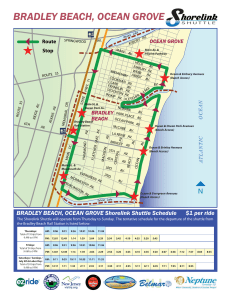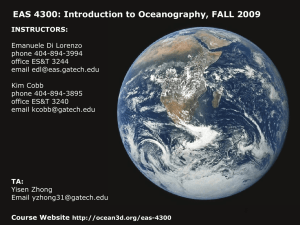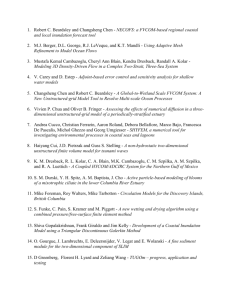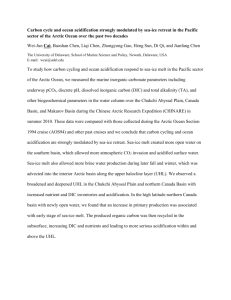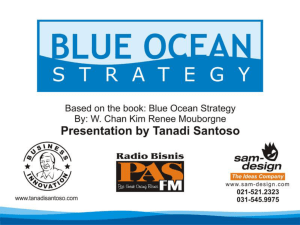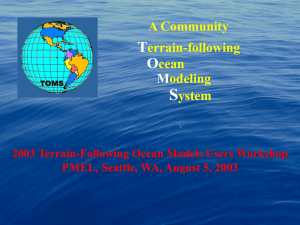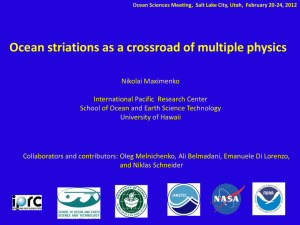BP_2006 - Emanuele Di Lorenzo
advertisement
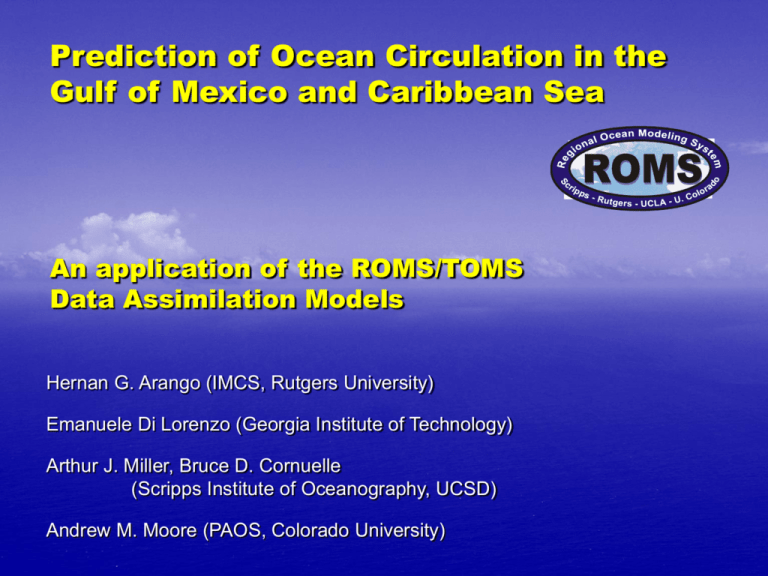
Prediction of Ocean Circulation in the Gulf of Mexico and Caribbean Sea An application of the ROMS/TOMS Data Assimilation Models Hernan G. Arango (IMCS, Rutgers University) Emanuele Di Lorenzo (Georgia Institute of Technology) Arthur J. Miller, Bruce D. Cornuelle (Scripps Institute of Oceanography, UCSD) Andrew M. Moore (PAOS, Colorado University) Ocean Observations Gulf of Mexico and Caribbean Seas plus satellite data (SSH, SST) and radar Ocean Modeling Framework ROMS/TOMS PROPAGATOR NL_OCEAN M A S T E R AIR_OCEAN TLM eigenmodes Forcing singular vectors Stochastic optimals Pseudospectra TL_OCEAN RP_OCEAN OCEAN Optimal pertubations ADM eigenmodes INITIALIZE AD_OCEAN RUN ADSEN_OCEAN FINALIZE S4DVAR_OCEAN KERNEL NLM, TLM, RPM, ADM physics biogeochemical sediment sea ice IS4DVAR_OCEAN ESMF W4DVAR_OCEAN ENSEMBLE_OCEAN Re io M o d e li n Ocean g S na l y st em g SANITY CHECKS R es e a rc h C o mm u ni ty TLCHECK_OCEAN PICARD_OCEAN GRAD_OCEAN PERT_OCEAN Ocean Modeling of North Atlantic Gulf of Mexico Ocean Model Grid Ocean Model Surface Currents and Sea Level Ocean Modeling Applications in Gulf of Mexico and Caribbean Seas • Develop a real-time data assimilation and prediction system for the Gulf of Mexico and Caribbean Seas based on a continuous upper ocean monitoring system • Demonstrate the utility of variational data assimilation in a real-time, sea-going environment • Demonstrate the value of collecting routine ocean observations from specially equipped ocean vessels (Explorer of the Seas) • Develop much needed experience in both the assimilation of disparate ocean data and ocean prediction in regional ocean models. • Add platform oceanic measurements (a possibility) Ensemble Prediction For an appropriate forecast skill measure, s Predictable Unpredictable High Spread Low Spread s s t time t time Ocean Adjoint Modeling Applications Kelvin Wave Pattern SSH Time=t0 Maximum transport SSH Time=tN Example from the Caribbean model run, of sensitivity of the transport through the Yucatan Strait given a particular realization of the circulation. In this case the maximum transport at time tN, indicated by the strong gradients in sea surface height (SSH), is sensitive to a pattern of Kelvin waves at previous time t0. These types of sensitivity, computed using the non-linear and Adjoint models of ROMS, will be applied for the Florida Strait to explore how different topographic shapes affect the transport during different circulation regimes. 4D Variational Data Assimilation Platforms (4DVAR) • Strong Constraint (S4DVAR) drivers: Conventional S4DVAR: outer loop, NLM, ADM Incremental S4DVAR: inner and outer loops, NLM, TLM, ADM (Courtier et al., 1994) Efficient Incremental S4DVAR (Weaver et al., 2003) • Weak Constraint (W4DVAR) - IOM Indirect Representer Method: inner and outer loops, NLM, TLM, RPM, ADM (Egbert et al., 1994; Bennett et al, 1997) Normalized misfit Strong Constraint 4DVAR from IOM misfit variance reduced 62% 8 1st guess IOM solution 6 4 2 (Di Lorenzo et al., 2005) 0 -2 -4 T -6 -8 0 2000 S U 4000 V 6000 8000 Free Surface Surface NS Velocity SST 0.5 36 TRUE 0.1 36 0 0 34 -0.1 32 -128 -0.2 -126 -124 -122 -120 -118 34 32 -128 34 -0.5 -126 -124 -122 -120 -118 32 -128 -126 -124 -122 -120 -118 -126 -124 -122 -120 -118 -126 -124 -122 -120 -118 0.5 1 st GUESS 36 0.1 36 0 34 -0.1 32 -128 36 -0.2 -126 -124 -122 -120 -118 0 34 32 -128 34 -0.5 -126 -124 -122 -120 -118 32 -128 0.5 IOM solution 36 0.1 36 0 34 -0.1 32 -128 36 -0.2 -126 -124 -122 -120 -118 0 34 34 -0.5 32 -128 -126 -124 -122 -120 -118 32 -128 Strong and Weak Constraint 4DVAR (Southern California Bight) T Assimilated data: TS 0-500m Free surface Currents 0-150m S Normalized Misfit V U Datum True Synthetic Data SST 0-500 m data 1st Guess Annual Climatology Strong Constraint SST Weak Constraint SST SST CalCOFI Sampling grid Adjoint Sensitivity • Given the model state vector: • Consider a Yucatan Strait transport index, J , defined in terms of space and/or time integrals of : • Small changes d in will lead to changes dJ in J where: J J J J J dJ du dv dT dS u v T S • We will define sensitivity as d + … J J J , , , u v T etc. Publications Arango, H.G., Moore, A.M., E. Di Lorenzo, B.D. Cornuelle, A.J. Miller and D. Neilson, 2003: The ROMS Tangent Linear and Adjoint Models: A comprehensive ocean prediction and analysis system, Rutgers Tech. Report. http://marine.rutgers.edu/po/Papers/roms_adjoint.pdf Di Lorenzo, E., A.M. Moore, H.G. Arango, B. Chua, B.D. Cornuelle, A.J. Miller and A. Bennett, 2005: The Inverse Regional Ocean Modeling System: Development and Application to Data Assimilation of Coastal Mesoscale Eddies, Ocean Modelling, In preparation. Moore, A.M., H.G Arango, E. Di Lorenzo, B.D. Cornuelle, A.J. Miller and D. Neilson, 2004: A comprehensive ocean prediction and analysis system based on the tangent linear and adjoint of a regional ocean model, Ocean Modelling, 7, 227-258. http://marine.rutgers.edu/po/Papers/Moore_2004_om.pdf Moore, A.M., E. Di Lorenzo, H.G. Arango, C.V. Lewis, T.M. Powell, A.J. Miller and B.D. Cornuelle, 2005: An Adjoint Sensitivity Analysis of the Southern California Current Circulation and Ecosystem, J. Phys. Oceanogr., In preparation. Wilkin, J.L., H.G. Arango, D.B. Haidvogel, C.S. Lichtenwalner, S.M.Durski, and K.S. Hedstrom, 2005: A Regional Modeling System for the Long-term Ecosystem Observatory, J. Geophys. Res., 110, C06S91, doi:10.1029/2003JCC002218. http://marine.rutgers.edu/po/Papers/Wilkin_2005_jgr.pdf Warner, J.C., C.R. Sherwood, H.G. Arango, and R.P. Signell, 2005: Performance of Four Turbulence Closure Methods Implemented Using a Generic Length Scale Method, Ocean Modelling, 8, 81-113. http://marine.rutgers.edu/po/Papers/Warner_2004_om.pdf Background Material Overview • Let’s represent NLM ROMS as: • The TLM ROMS is derived by considering a small perturbation s to S. A first-order Taylor expansion yields: A is real, non-symmetric Propagator Matrix • The ADM ROMS is derived by taking the inner-product with an arbitrary vector , where the inner-product defines an appropriate norm (L2-norm): Tangent Linear and Adjoint Based GST Drivers • Eigenmodes of R (0, t ) and • Singular vectors: T R (t,0) T R (t,0) XR(0, t ) T • Forcing Singular vectors: R(t, )dt X R(t , )dt 0 0 |t t '|/ tc T ' e R ( , t ) XR(t , )dt ' dt • Stochastic optimals: 0 0 • Pseudospectra: I A H I A 1 Two Interpretations • Dynamics/sensitivity/stability of flow to naturally occurring perturbations • Dynamics/sensitivity/stability due to error or uncertainties in the forecast system • Practical applications: Ensemble prediction Adaptive observations Array design ... GSA on the Southern California Bight (SCB) SST and Surface currents Free-Surface Eigenmodes • TLM eigenvectors (A): normal modes • ADM eigenvectors (AT): optimal excitations Real Part Imag Part SCB coastally trapped waves Optimal Perturbations • A measurement of the fastest growing of all possible perturbations over a given time interval diffluence confluence SCB maximum growth of perturbation energy over 5 days Stochastic Optimals Provide information about the influence of stochastic variations (biases) in ocean forcing SCB patterns of stochastic forcing that maximizes the perturbation energy variance for 5 days Singular Vectors Open Boundary Sensitivity: errors growth quickly and appear to propagate through the model domain as coastally trapped waves. Ensemble Prediction • Optimal perturbations / singular vectors and stochastic optimal can also be used to generate ensemble forecasts. • Perturbing the system along the most unstable directions of the state space yields information about the first and second moments of the probability density function (PDF): ensemble mean ensemble spread • Adjoint based perturbations excite the full spectrum Data Assimilation Overview • Cost Function: where model, background, observations, inverse background error covariance, inverse observations error covariance • Model solution depends on initial conditions ( boundary conditions, and model parameters • Minimize J to produce a best fit between model ), and observations by adjusting initial conditions, and/or boundary conditions, and/or model parameters. Minimization • Perfect model constrained minimization (Lagrange function): We require the minimum of , , at which: , yielding • AT is the transpose of A, often called the adjoint operator. It can be shown that: The adjoint equation solution provides gradient information 4D Variational Data Assimilation Platforms (4DVAR) • Strong Constraint (S4DVAR) drivers: Conventional S4DVAR: outer loop, NLM, ADM Incremental S4DVAR: inner and outer loops, NLM, TLM, ADM (Courtier et al., 1994) Efficient Incremental S4DVAR (Weaver et al., 2003) • Weak Constraint (W4DVAR) - IOM Indirect Representer Method: inner and outer loops, NLM, TLM, RPM, ADM (Egbert et al., 1994; Bennett et al, 1997) RP: Forward and Adjoint MPI Communications AsendE TILE L ArecvE ArecvW AsendW TILE R receive Jend Jend Forward i-2 i-1 i i+1 i-2 i-1 i i+1 Jstr Jstr send Istr V iL = V iL+1 = TILE L Iend R Vi V iR+1 AsendE Istr V iR-2 = V iR-1 = ArecvE ArecvW AsendW Iend L V i-2 V iL-1 TILE R ad_send Jend Jend Adjoint i-2 i-1 i i+1 i-2 i-1 i i+1 Jstr Jstr ad_receive Istr ad_V iL-2 = Iend L ad_V i-2 + ad_V iR-2 Istr R ; V i-2 = 0 ad_V iL-1 = ad_V iL-1 + ad_V iR-1 ; V iR-1 = 0 ad_V iR = ad_V iR + Iend L i L ; Vi =0 ad_V iR+1 = ad_V iR+1 + ad_V iL+1 ; V iL+1 = 0
